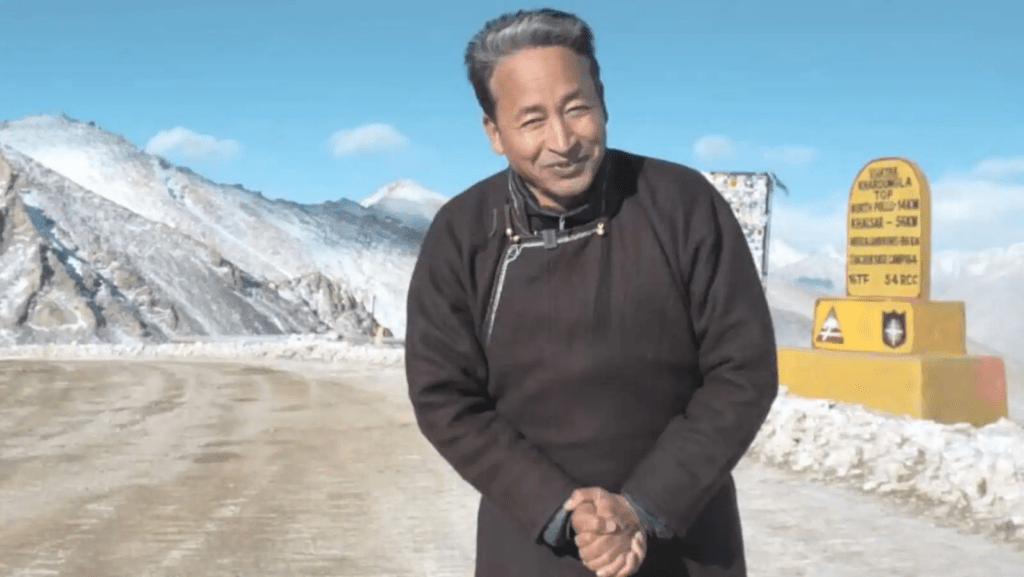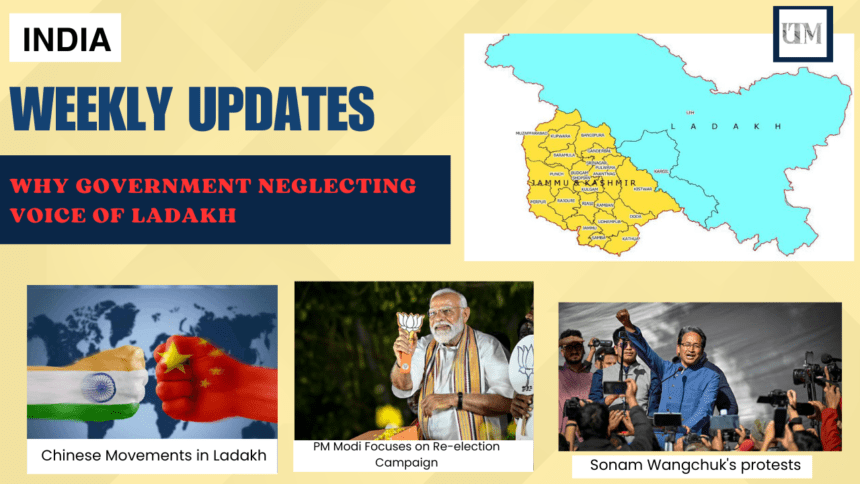The serene landscapes of Ladakh have lately become a backdrop to an extensive and sustained protest. This movement, which started out as a regional cry for attention, has now echoed throughout India, drawing national and international attention. In this article we will talk about from neglecting Ladakh to PM Modi focusing on re-election campaign.
The protests are are response to a complicated interplay of geopolitical, environmental, and administrative issues. Central to the talk is the distinguished Sonam Wangchuk, an engineer and schooling reformist, whose allegations and next movements have delivered layers of urgency and drama to the unfolding occasions.
The protests in Ladakh: A Result of the 2019 State Bifurcation
The protests in Ladakh hint their origins returned to the bifurcation of the state of Jammu and Kashmir in August 2019. The imperative authorities of India revoked Article 370, stripping Jammu and Kashmir of its unique fame and splitting it into Union Territories Jammu & Kashmir and Ladakh.
This choice, at the same time as hailed in some quarters, was met with trepidation and opposition in others, especially in Ladakh. Residents of Ladakh, a place with a completely unique cultural and ecological landscape, have expressed worries over the potential socio-economic and environmental influences of this reorganization.
The neighborhood populace feared that the direct management from Delhi might forget the awesome desires and sensitivities of Ladakh.
Key Demands
The primary needs of the protestors have evolved however continually awareness on the following regions:
6th time table of the charter :
Protesters demand inclusion beneath the sixth agenda, which presents for the management of tribal areas within the northeastern states of India. This would supply Ladakh a degree of autonomy and guard its unique cultural history and land from outside exploitation.
Statehood for Ladakh
Some other significant demand is for full statehood for Ladakh. This would permit for more neighborhood governance and illustration, ensuring selections are made toward the floor realities of the area.
Protection of Land and Jobs
There may be a strong call for legal guidelines to safeguard the land and employment possibilities for the nearby population. This stems from fears that external investment and migration ought to displace locals and erode their conventional life.
“Government’s Weak Response Fuels Ladakh Protests”
Neglecting Ladakh has been done for some quite time. Not with standing the continued protests and clean articulation of needs, the principal’s response has been tepid. preliminary engagements with the protestors did now not yield any big commitments or timelines.
This perceived indifference has fueled the protests further, with neighborhood leaders and the overall populace feeling an increasing number of marginalized.
Sonam Wangchuk’s Allegations
Sonam Wangchuk, a amend engineer and innovator, has emerged as a pivotal figure within the Ladakh protests. acknowledged for his pioneering work in sustainable development and education, Wangchuk’s involvement has lent the motion both credibility and visibility.

Wangchuk has made numerous startling allegations, together with claims that China has encroached upon Indian territory in Ladakh. He argues that the important authorities are downplaying or outright denying these incursions to keep away from political and diplomatic fallout.
Government’s managing and Wangchuk’s Activism
Those claims have been staunchly denied by way of the Ministry of domestic Affairs, the Ministry of external Affairs, and other authorities. The professional stance is that there were no full-size modifications inside the border with China.
In response to Wangchuk’s activism, the primary government has followed a hardline stance. Reports have emerged that Wangchuk was forced to cancel his planned march, a flow seen via many as an attempt to stifle dissent and restrict the protest’s visibility. It shows how government is neglecting Ladakh.
This alleged intimidation has intensified the protests, galvanizing help for Wangchuk and his cause. The scenario escalated while Wangchuk began a symbolic speedy to attract interest to the protestors’ needs and the alleged encroachment by way of China. His fasting became seen as a desperate plea for acknowledgement and movement from the relevant authorities.
Geopolitical Implications
Wangchuk’s allegations concerning Chinese encroachment upload a giant geopolitical dimension to the protests. The Line of real control (LAC), the de facto border among India and China in Ladakh, has been a longstanding flashpoint. Tensions have periodically flared, most substantially in 2020 in the course of the Galwan Valley clash, which led to casualties on each side.
Wangchuk’s assertions advise that the scenario alongside the LAC may be more unstable than officially recounted. If proper, this can mean strategic territorial losses for India, doubtlessly changing the nearby stability of strength.
The significant government’s reluctance to interact openly in this difficulty may also stem from the touchy nature of India-China family members and the broader implications for national safety.
Environmental and Socio-monetary concerns
Beyond the geopolitical tensions, the protests additionally spotlight sizable environmental and socio-financial issues. Ladakh’s fragile atmosphere is under risk from improved tourism, infrastructural improvement, and weather exchange. Protesters argue that guidelines made in Delhi won’t effectively don’t forget those neighborhood environmental concerns.
Economically, the centralization of energy and resources in Delhi ought to exacerbate inequalities, leaving Ladakh’s unique desires unmet. The call for neighborhood governance and autonomy is rooted in a preference to shield Ladakh’s surroundings and ensure sustainable improvement that benefits its citizens.
The Path Forward for Ladakh: Addressing Protest Concerns and Ensuring Sustainable Development
The continued protests in Ladakh constitute a vital juncture for the place and the relevant authorities. Addressing the protestors’ demands calls for a nuanced technique that balances countrywide pastimes with regional aspirations and sensitivities.
Engagement and speak :
The crucial authorities have to interact in meaningful talk wit protest leaders and the nearby population. recognizing the legitimacy of their worries and working in the direction of a jointly agreeable solution is important.
Obvious policy-Making
Ensuring transparency in policy-making, particularly concerning land and activity protection legal guidelines, can assist build trust. imposing the sixth agenda or presenting statehood will be considered to provide Ladakh more autonomy.
Environmental protection
Policies should prioritize environmental sustainability. Shielding Ladakh’s unique atmosphere must be a key consideration in any development plan.
Geopolitical Clarity
Addressing the allegations of Chinese language encroachment transparently is crucial. While countrywide protection concerns are valid, keeping public self belief calls for a clean and sincere articulation of the scenario on the borders.
Ladakh protests aren’t merely a local difficulty however a reflection of broader challenges going through India’s governance, environmental policy, and geopolitical approach. The vital government’s reaction, or lack thereof, to those protests will have lasting implications for the place and beyond.
The scenario calls for a careful balance of neighborhood autonomy, environmental stewardship, and countrywide security, making sure that the voices of Ladakh’s residents are heard and respected within the corridors of strength.
What is the High Powered Committee (HPC) involved in the negotiations on these issues?
In Kargil district, which has almost always aligned itself with J&K, protests began almost immediately after the changes of August 5, 2019.
After the unhappiness in Leh too took root, both these regions of Ladakh came together to form two pressure groups — Apex Body Leh (ABL) and Kargil Democratic Alliance (KDA). Both ABL and KDA are joint platforms of social, political, and religious bodies in Leh and Kargil, and enjoy a lot of support from the people of the region.
Government Pushback Thwarts Ladakh Protest Marches
On March 4, the fourth round of discussions ended inconclusively. On March 26, while ending his 21-day fast, Wangchuk said that the Prime Minister and Home Minister would have to be “statesmen”, and show “some character and far-sightedness.”
To stop the April 7 Pashmina March, the Ladakh administration imposed Section 144 CrPC and put curbs on the Internet. Wangchuk alleged that some people were detained overnight, and called off the march.
On April 14, Wangchuk announced a second attempt at the Pashmina March. However, this too has been suspended, allegedly after “pressure from the administration”. Wangchuk has said that permission was given for only a single day’s march, and only as far as the Indian Army allows.
“They have told us that if we make attempts to go toward the China border, they will impose section 144 for two months and that will affect tourism in the area. We have our answer. In any other country where the government was interested in clearing the confusion around the situation at the border, they would have allowed us,” he said.
China’s Encroachment in Ladakh
The allegations of Chinese encroachment are a crucial aspect of the Ladakh protests, adding a significant geopolitical dimension to the unrest. The Line of Actual Control (LAC), the de facto border between India and China in Ladakh, has been a longstanding flashpoint.
Tensions have periodically flared, most notably in 2020 during the Galwan Valley clash, which resulted in
casualties on both sides.
Details of the Clashes and Encroachments
In June 2020, a violent skirmish erupted in the Galwan Valley, leading to the deaths of 20 Indian soldiers and an undisclosed number of Chinese troops.
This clash was the first deadly encounter between the two armies in decades, bringing the world’s attention to the volatile nature of the LAC. Subsequent satellite imagery and reports suggested that China had made significant advancements in constructing military infrastructure in disputed areas, raising alarm in India.
Wangchuk’s assertions suggest that the situation along the LAC may be more volatile than officially acknowledged. He claims that China has incrementally occupied several acres of land that traditionally belonged to India.
If true, this could imply strategic territorial losses for India, potentially altering the regional balance of power. The central government’s reluctance to engage openly on this issue may stem from the sensitive nature of India-China relations and the broader implications for national security.
Geopolitical Implications
Wangchuk’s allegations regarding Chinese encroachment add a significant geopolitical dimension to the protests. If the Indian government acknowledges these claims, it could lead to increased military presence and infrastructure development along the LAC, potentially heightening tensions with China.
The central government might be attempting to manage these tensions quietly to avoid escalating the situation further, but this approach has not assuaged the fears of Ladakh’s residents.
Environmental and Socio-Economic Concerns
Economically, the centralization of power and resources in Delhi could exacerbate inequalities, leaving Ladakh’s unique needs unmet. The demand for local governance and autonomy is rooted in a desire to protect Ladakh’s environment and ensure sustainable development that benefits its residents.
The Role of Civil Society and Media
Civil society and media play a crucial role in shaping the discourse around the protests. Non-governmental organizations, local community leaders, and activists have been instrumental in mobilizing support and maintaining the momentum of the movement.
The media, both local and national, has a responsibility to provide balanced coverage, highlighting the protestors’ perspectives and the government’s responses.
The involvement of figures like Sonam Wangchuk has drawn significant media attention, but there is a need for comprehensive reporting that goes beyond individual personalities. Coverage should delve into the systemic issues at play, ensuring a nuanced understanding of the protestors’ demands and the broader socio-political context.
Potential Outcomes and Long-Term Implications
The outcome of the Ladakh protests will significantly impact the region’s future and potentially set precedents for other parts of India facing similar issues. This happen because government was neglecting Ladakh. There are several potential scenarios:
Government Concessions
The central government might concede to some of the protestors’ demands, such as implementing protective laws for land and jobs or granting greater autonomy through the Sixth Schedule. This could help pacify the protestors and provide a framework for sustainable development.
Prolonged Stalemate
If the government continues to delay meaningful engagement, the protests could continue indefinitely, leading to increased frustration and potential instability in the region. This could also embolden other regions with grievances, leading to wider unrest.
Escalation of Repression
A heavy-handed approach by the government, including further attempts to silence activists and protest leaders, could escalate tensions. This might result in more significant national and international scrutiny, putting additional pressure on the government to act.
Geopolitical Ramifications
: If Wangchuk’s allegations about Chinese encroachment gain more traction, it could force the government to take a firmer stance on the issue. This might lead to increased military presence and infrastructure development along the LAC, potentially heightening tensions with china.
Conclusion
The Neglecting Ladakh was been doing for some time. Ladakh’s protests are not merely a regional issue but a reflection of broader challenges facing India’s governance, environmental policy, and geopolitical strategy.
The central government’s response, or lack thereof, to these protests will have lasting implications for the region and beyond. The situation calls for a careful balance of local autonomy, environmental stewardship, and national security, ensuring that the voices of Ladakh’s residents are heard and respected in the corridors of power.




